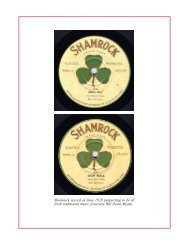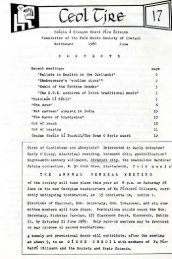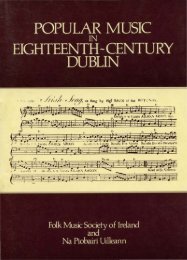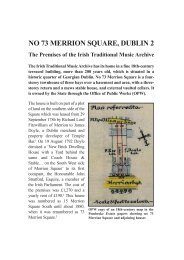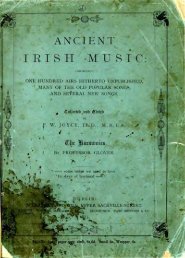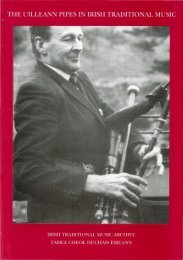Union Pipes - Irish Traditional Music Archive
Union Pipes - Irish Traditional Music Archive
Union Pipes - Irish Traditional Music Archive
Create successful ePaper yourself
Turn your PDF publications into a flip-book with our unique Google optimized e-Paper software.
COURTNEY’S ‘UNION PIPES’ AND THE TERMINOLOGY OF IRISH BELLOWS-BLOWN BAGPIPES 54<br />
Scottish idiom for the Ossianic hit show Oscar and Malvina (for<br />
which he dresses in Scottish costume). On the other hand, when he<br />
goes to perform in Dublin in 1793 he certainly plays the expected<br />
music from his Covent Garden hit but (billed as ‘Mr. Courtney’ and<br />
often as playing ‘bagpipes’ rather than ‘union pipes’) he also for the<br />
first time, as has been seen, advertises specific <strong>Irish</strong> melodies. Only<br />
towards the end of his London career does he begin to call his<br />
instrument ‘<strong>Irish</strong> pipes’ and begin to introduce <strong>Irish</strong> melodies on<br />
stage there.<br />
The only known illustration of Courtney and his pipes (for which<br />
click here) gives little help in understanding the explanation of The<br />
Times for ‘union pipes’. Shown in an engraving of a 1790s sketch by<br />
Isaac Cruikshank, he is playing pipes on stage in Oscar and<br />
Malvina. Sitting, with one leg crossed over the other, he is certainly<br />
playing bellows pipes (an elbow-strap is visible and there is no blowpipe<br />
in evidence). But it seems an oddly undeveloped and toy-like<br />
form of the instrument when compared with, say, the surviving<br />
contemporary two-octave <strong>Irish</strong> instruments made by Egan of Dublin<br />
and Kenna of Westmeath. 157 These were instruments of a type which<br />
already existed in the second half of the 1770s when Courtney, born<br />
in 1760, must have been learning the pipes. But the central elements<br />
of the pipes shown in the Courtney illustration stand in contrast with<br />
them. The chanter is short, with a noticeably conical exterior, and<br />
ends in a bell rather than being externally cylindrical and ending in a<br />
stoppable end-tenon. It is being played off the knee and could only<br />
therefore have produced music legato; it could not have varied<br />
melodies with staccato passages or staccato effects as the<br />
contemporary <strong>Irish</strong> instruments already could. Only two drones are<br />
apparent, in about a 3:2 length ratio, whereas <strong>Irish</strong> instruments<br />
157<br />
Both are known to have been making <strong>Irish</strong> pipes in the 1760s, see Donnelly<br />
1983: 7–11, Donnelly 2002: 2.14, 1–44.



